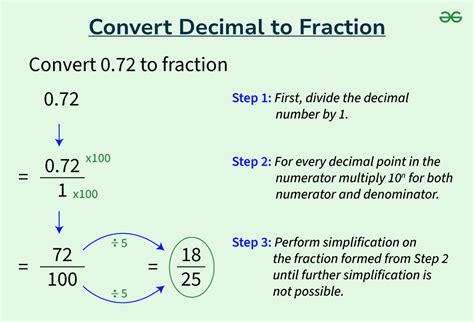How to Convert Decimals into Fractions: A Simple Guide
Converting decimals to fractions might seem daunting, but it's a straightforward process once you understand the underlying principles. This guide will walk you through different methods, ensuring you can confidently tackle any decimal-to-fraction conversion. We'll cover simple decimals, repeating decimals, and even offer some helpful tips and tricks along the way.
Understanding Place Value: The Foundation of Conversion
Before diving into the conversion process, it's crucial to understand decimal place values. Each digit to the right of the decimal point represents a fraction of 10, 100, 1000, and so on. For example:
- 0.1 represents one-tenth (1/10)
- 0.01 represents one-hundredth (1/100)
- 0.001 represents one-thousandth (1/1000)
This understanding forms the basis for converting decimals into their fractional equivalents.
Converting Simple Decimals to Fractions
Simple decimals are those with a finite number of digits after the decimal point. Here's a step-by-step guide:
-
Write the decimal as a fraction over 1: Place the decimal number as the numerator (top number) and 1 as the denominator (bottom number). For example, 0.75 becomes 0.75/1.
-
Multiply the numerator and denominator by a power of 10: Multiply both the numerator and the denominator by 10 raised to the power of the number of digits after the decimal point. For 0.75 (two digits after the decimal), you'd multiply by 10<sup>2</sup> (which is 100). This gives you 75/100.
-
Simplify the fraction: Reduce the fraction to its simplest form by finding the greatest common divisor (GCD) of the numerator and denominator and dividing both by it. The GCD of 75 and 100 is 25. Dividing both by 25 gives us the simplified fraction 3/4.
Example: Convert 0.625 to a fraction.
- 0.625/1
- (0.625 * 1000) / (1 * 1000) = 625/1000
- Simplify: 625/1000 = 5/8
Handling Repeating Decimals
Repeating decimals, such as 0.333... (0.3 recurring) or 0.142857142857... (0.142857 recurring), require a slightly different approach:
-
Assign a variable: Let 'x' equal the repeating decimal. For example, x = 0.333...
-
Multiply to shift the repeating part: Multiply both sides of the equation by a power of 10 that shifts the repeating part to the left of the decimal. In our example, multiplying by 10 gives 10x = 3.333...
-
Subtract the original equation: Subtract the original equation (x = 0.333...) from the multiplied equation (10x = 3.333...). This eliminates the repeating part: 10x - x = 3.333... - 0.333..., which simplifies to 9x = 3.
-
Solve for x: Solve for 'x' to find the fractional representation. In this case, x = 3/9, which simplifies to 1/3.
Example: Convert 0.142857142857... (recurring) to a fraction. This is more complex and requires a similar process as above but with more steps due to the longer repeating sequence.
Tips for Success
- Practice makes perfect: The more you practice, the easier it will become.
- Use online calculators: Many online calculators can help you verify your answers.
- Master simplifying fractions: Knowing how to simplify fractions is essential for getting the most accurate answer.
By following these steps and practicing regularly, you’ll master the art of converting decimals into fractions. Remember to break down the process step-by-step and don't be afraid to use tools and resources to assist you. Happy converting!
